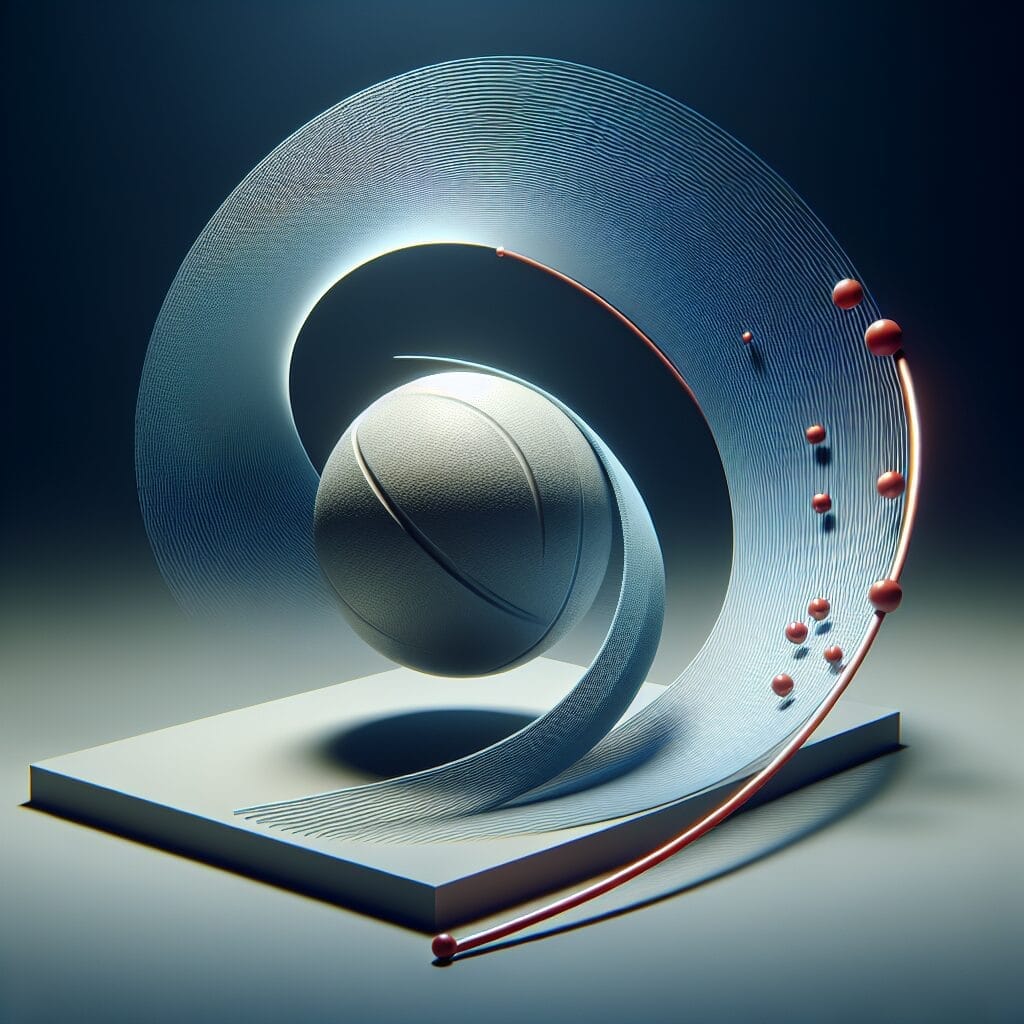Spin-Induced Curves: Unraveling Ball Movement
In the fascinating world of sports, the ability to manipulate the trajectory of a ball can often make the difference between success and failure. Enter spin-induced curves, a captivating phenomenon that has intrigued athletes, coaches, and fans alike. This mesmerizing technique involves applying spin to a ball, thus transforming its movement in unexpected ways. Whether it’s the graceful curve of a soccer ball bending around a wall, or the elusive spin of a baseball perplexing a batter, understanding the science behind spin-induced curves gives athletes a powerful advantage on the field.
The impact of spin-induced curves is truly remarkable. By harnessing the physical properties of a spinning ball, athletes can defy gravity and challenge the laws of motion. The artistry lies in imparting just the right amount of spin, enabling a ball to dip, swerve, or break unpredictably. This can leave opponents scrambling to adapt, as they struggle to anticipate the ball’s altered trajectory. Moreover, the ability to manipulate spin-induced curves can make a sport more exciting and dynamic, captivating audiences worldwide.
Now, let’s delve into the key takeaways to uncover the secrets behind spin-induced curves. We will explore the physics underlying this phenomenon, examining how different factors such as ball type, speed, and spin direction can influence the resulting movement. Additionally, we will unravel the techniques employed by athletes to generate spin-induced curves, unveiling the training methods and strategies they employ. By understanding these intricacies, we can gain valuable insights that will not only enhance our appreciation for the skill involved but potentially inspire us to venture onto the field and attempt our own spin-induced magic.
Key Takeaways
1. Spin-induced curves play a crucial role in determining the trajectory of a ball, influencing its movement unpredictably and making it difficult for batters to anticipate.
2. Different pitch types rely on various spinning techniques, including backspin, topspin, and sidespin, to produce unique movement patterns and deceive the opposing team.
3. The Magnus effect, a phenomenon that causes a spinning object to deviate from its expected path, contributes significantly to the spin-induced curves observed in baseball and other sports.
4. By manipulating the spin axis and spin rate of a pitched ball, pitchers can control the amount and direction of the curve, allowing them to strategically target specific areas of the strike zone and confuse batters.
5. Understanding the mechanics behind spin-induced curves is essential for players, coaches, and analysts, as it offers valuable insights into pitch selection, batter-pitcher matchups, and overall game strategy, ultimately leading to improved performance and a competitive advantage.
How Do Spin-Induced Curves Unravel Ball Movement?
Understanding Spin-Induced Curves
In the world of sports, spin-induced curves play a crucial role in determining the trajectory and movement of a ball. Whether it’s in baseball, soccer, or tennis, the spin applied to a ball can result in remarkable movements that can confuse opponents and lead to game-changing outcomes.
The Physics Behind Spin
Spin-induced curves are a result of the physical principles of angular momentum and aerodynamics. When a ball is spun, it creates an imbalance in the air pressure surrounding it, causing the ball to deviate from a straight path. The direction and magnitude of the curve depend on various factors such as the spin rate, spin axis, ball shape, and the speed at which it travels.
Spin in Baseball
In baseball, pitchers employ different types of pitches to create spin-induced curves. One famous example is the curveball, which involves applying topspin or backspin to the ball. The rotation and tilt of the ball cause it to drop or move sideways as it approaches the batter, making it challenging to hit accurately.
Spin in Soccer
Spin-induced curves are also prevalent in soccer, particularly in free kicks and corner kicks. By imparting spin on the ball, players can make it bend in mid-air, deceiving the goalkeeper and increasing the chances of scoring a goal. The famous “Bend it like Beckham” technique showcases the potential of spin-induced curves in soccer.
Spin in Tennis
Tennis players utilize spin-induced curves to enhance their shots and outmaneuver their opponents. By applying topspin, backspin, or sidespin to the ball, players can control its trajectory and make it more challenging to return. Spin-induced curves in tennis are fundamental in shots like the topspin forehand, slice backhand, and the powerful spin serve.
Mastering Spin-Induced Curves
Becoming proficient in spin-induced curves requires practice, precision, and an understanding of the mechanics behind it. Here are some tips to help you master the art of spin-induced curves:
- Experiment with different spins: Try applying various types of spins to a ball and observe how they affect its movement. This will help you develop a feel for the kind of spin-induced curve you desire.
- Focus on technique: Good technique is crucial when executing spin-induced curves. Pay attention to your grip, body positioning, and contact point to ensure maximum control over the spin.
- Study the game: Analyze how professionals use spin-induced curves in your chosen sport. Watch matches, study techniques, and learn from experts to improve your understanding and execution of spin.
- Practice consistency: Regular practice is essential to develop muscle memory and improve your ability to consistently produce spin-induced curves. Dedicate time to refine your technique and experiment with different scenarios.
- Seek expert guidance: Consider working with a coach or trainer who can provide personalized feedback and guidance to help you enhance your spin-induced curve skills.
Frequently Asked Questions
What is spin-induced curve?
Spin-induced curve, also known as “movement on the ball,” refers to the ability of a ball to deviate from its straight trajectory due to the spin imparted on it by the thrower or the hitter.
How does spin affect the movement of a ball?
Spin influences the airflow around the ball, creating differences in air pressure on different sides. This pressure difference causes the ball to deviate from its expected path, resulting in a curve or movement.
What sports commonly utilize spin-induced curves?
Spin-induced curves are prominently observed in sports such as baseball, tennis, cricket, and soccer. Pitchers, tennis players, bowlers, and footballers strategically use spin to manipulate the trajectory and make it difficult for opponents to anticipate or react.
Can spin-induced curves be controlled?
While it requires practice and skill, spin-induced curves can be controlled to a certain extent by knowledgeable players. Through proper technique and understanding of spin mechanics, athletes can influence the direction and amount of curve in their shots or throws.
What types of spin are commonly used for inducing curve?
The commonly used spins for inducing curves are topspin, backspin, and sidespin. Each spin type produces a distinct movement pattern, allowing players to add variety to their shots and throws.
How does topspin affect ball movement?
Topspin is a type of spin that causes the ball to rotate forward. In sports like tennis and soccer, topspin leads to the ball dipping downward or bouncing higher upon impact, making it challenging for opponents to intercept or return the shot effectively.
What is the role of backspin in creating curve?
Backspin involves the ball spinning backward. This spin creates a lift force, allowing the ball to stay in the air longer, defy gravity, and produce a higher curve. It is often employed in sports like golf and soccer for shots requiring elevation and distance control.
How does sidespin influence ball movement?
Sidespin refers to the rotation of the ball around its horizontal axis. It causes the ball to curve sideways, enabling players to bend shots or throws around obstacles or opponents. Sidespin is frequently used in sports like snooker, pool, and table tennis.
Can spin-induced curves be countered?
While it can be challenging to counter spin-induced curves, there are defensive strategies to mitigate their effect. Anticipating the spin, maintaining positioning, and adapting to the movement are crucial for intercepting or countering curve shots or throws.
How can understanding spin-induced curves improve gameplay?
Understanding spin-induced curves enhances gameplay by providing players with an advantage. It allows them to create unpredictable shots, deceive opponents, and gain greater control over the ball’s movement. Additionally, knowledge of spin can aid in reading and countering opponents’ strategies effectively.
Final Thoughts
Spin-induced curves play a significant role in numerous sports, adding an additional layer of excitement, strategy, and skill to the game. The mastery of ball movement influenced by spin requires dedication, practice, and a deep understanding of the mechanics involved. Whether it’s the breathtaking curve of a baseball pitch or the mesmerizing spin of a tennis stroke, the study and utilization of spin-induced curves continue to captivate players, coaches, and fans alike.
Exploring the intricate world of spin-induced curves not only offers an appreciation for the physics behind ball movement but also sheds light on the creativity and innovation athletes bring to their respective sports. It highlights the power of knowledge and technique in shaping gameplay, making spin-induced curves an intriguing aspect to unravel and master. So next time you marvel at the astonishing movement of a ball, remember the unwavering influence of spin that contributes to its mesmerizing journey.




